When the file is too large, I open the pic in "edit" and change the size to a smaller percent and then I'm able to download. That might work for you.@JoyfulNoise I took some pics for you this morning, but I keep getting a message that “file is too Lg for the server...”
Help!!! Yikes!
- Thread starter tessv
- Start date
You are using an out of date browser. It may not display this or other websites correctly.
You should upgrade or use an alternative browser.
You should upgrade or use an alternative browser.
- Jul 3, 2015
- 175
- Pool Size
- 38500
- Surface
- Plaster
- Chlorine
- Salt Water Generator
- SWG Type
- Jandy Aquapure 1400
Thanks! Yep, with phone... turned off the auto HDR setting and will retake those shots after a little while.How did you take your pics? If on a phone with HDR, turn HDR setting off. HDR creates pic files too large for TFP.
- Jul 3, 2015
- 175
- Pool Size
- 38500
- Surface
- Plaster
- Chlorine
- Salt Water Generator
- SWG Type
- Jandy Aquapure 1400
So I know you’re not focused on this at the moment but could you provide a few closer up shots of that ledge, especially near the accent tile?
Are there missing tiles there or are they just covered over?
Even down that first step looks really bad. I’m curious to see the plaster.
Ok, @JoyfulNoise, let’s try this again... turning off HDR worked!
Okay, so this first shot is of the tanning ledge... we had freeze/thaw damage last year, too—always confined to that ledge. Last year they ground the ledge back to smooth where it had eroded, hence the dips in it now where you see water...
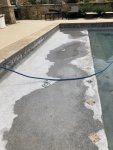
A couple of close up shots... oh, and a note about this creative tiling pattern... isn’t the prettiest, mostly serves to mark the edge of the step, I spose...
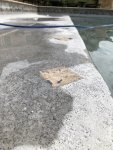
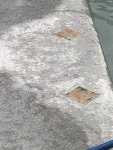
Waterline tile (btw, how do we get the white off?)
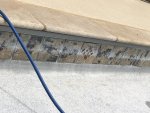
This shot, I tried to get the steps and a little of the bench...
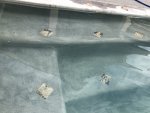
Let me know if ya need additional shots...
Last edited:
- Jul 3, 2015
- 175
- Pool Size
- 38500
- Surface
- Plaster
- Chlorine
- Salt Water Generator
- SWG Type
- Jandy Aquapure 1400
In that bench/step shot—there is no discoloration there—just a weird reflection on the water...
- May 23, 2015
- 25,695
- Pool Size
- 16000
- Surface
- Plaster
- Chlorine
- Salt Water Generator
- SWG Type
- Pentair Intellichlor IC-60
That ledge looks terrible. The PB should be ashamed of that and make it right - complete chip out and replaster. At a minimum, the ledge should be completely redone, no patches.
I would also have a very frank discussion with the PB about implementing a closing strategy that does NOT drain that ledge. I realize that they are concerned about a complete freeze of water all the way down but that is an extreme in my opinion. Even in freezing environments, if that water was properly covered AND something was done to add agitation (perhaps a submersible pump), water will take a long time to freeze and would not likely freeze completely. Draining a ledge and leaving it exposed to rapidly fluctuating air temperatures when it is sitting millimeters away from a body of water that is only changing its temp slowly is a recipe for continued freeze-thaw damage.
Just sayin’ ....
I would also have a very frank discussion with the PB about implementing a closing strategy that does NOT drain that ledge. I realize that they are concerned about a complete freeze of water all the way down but that is an extreme in my opinion. Even in freezing environments, if that water was properly covered AND something was done to add agitation (perhaps a submersible pump), water will take a long time to freeze and would not likely freeze completely. Draining a ledge and leaving it exposed to rapidly fluctuating air temperatures when it is sitting millimeters away from a body of water that is only changing its temp slowly is a recipe for continued freeze-thaw damage.
Just sayin’ ....
- Jul 3, 2015
- 175
- Pool Size
- 38500
- Surface
- Plaster
- Chlorine
- Salt Water Generator
- SWG Type
- Jandy Aquapure 1400
I’m hoping when they come this week to check our progress, they will make the same observation as you... otherwise, I’m gonna need to get my big girl panties on and have a tough conversation... he’s a great guy, and is the most tenured/respected PB in our area...
What would a well-done chip out/replaster entail??? How would we know it had been done “correctly”?
What would a well-done chip out/replaster entail??? How would we know it had been done “correctly”?
Last edited:
- Jul 3, 2015
- 175
- Pool Size
- 38500
- Surface
- Plaster
- Chlorine
- Salt Water Generator
- SWG Type
- Jandy Aquapure 1400
And I’m intrigued by your idea for a new closing procedure... so, if doing something like that, what about the pipes?
- May 23, 2015
- 25,695
- Pool Size
- 16000
- Surface
- Plaster
- Chlorine
- Salt Water Generator
- SWG Type
- Pentair Intellichlor IC-60
I’m no plastering expert but I think you’d have to chip everything out on that ledge and then down the first step so that the seam between the old and new plaster is not at the roll-off point of that first step down. A seam on the vertical rise would not be as noticeable as on the ledge.
A better and more costly solution (since it’s your money and not mine ) would be to tile that entire ledge. It’s not a huge surface area like the rest of the pool but tile would be more immune to freeze/thaw damage and it’s far easier to fix a tile that pops off than it is to fix an eroded or spalled plaster surface.
) would be to tile that entire ledge. It’s not a huge surface area like the rest of the pool but tile would be more immune to freeze/thaw damage and it’s far easier to fix a tile that pops off than it is to fix an eroded or spalled plaster surface.
If you kept that area submerged, then the bubbler/fountain lines would need to be air blown and sealed with plug in the winter. You’d want to backfill those lines with antifreeze. If one were to apply a little bit of ingenuity and find the right sized threaded fitting, you could build up a standpipe that replaces the fountains jet orifice and then easily blow out the lines and seal them. It would look line three periscopes sticking up above the water’s surface. You could then fill them with antifreeze to avoid pipe damage. More complicated? Sure. But the alternative is to keep doing what they’re doing and having a high chance of damaged plaster every opening.
A better and more costly solution (since it’s your money and not mine
If you kept that area submerged, then the bubbler/fountain lines would need to be air blown and sealed with plug in the winter. You’d want to backfill those lines with antifreeze. If one were to apply a little bit of ingenuity and find the right sized threaded fitting, you could build up a standpipe that replaces the fountains jet orifice and then easily blow out the lines and seal them. It would look line three periscopes sticking up above the water’s surface. You could then fill them with antifreeze to avoid pipe damage. More complicated? Sure. But the alternative is to keep doing what they’re doing and having a high chance of damaged plaster every opening.
- Jul 3, 2015
- 175
- Pool Size
- 38500
- Surface
- Plaster
- Chlorine
- Salt Water Generator
- SWG Type
- Jandy Aquapure 1400
@JoyfulNoise, I think we both love the idea of tiling that ledge—for both practical and aesthetic reasons... will see!!!
Also really interested to pitch your winterizing idea to the PB!
THANK YOU!!!!
Question—at what speed should a variable speed pump run throughout a slam?
Also really interested to pitch your winterizing idea to the PB!
THANK YOU!!!!
Question—at what speed should a variable speed pump run throughout a slam?
- Jul 3, 2015
- 175
- Pool Size
- 38500
- Surface
- Plaster
- Chlorine
- Salt Water Generator
- SWG Type
- Jandy Aquapure 1400
- May 3, 2014
- 62,674
- Pool Size
- 6000
- Surface
- Fiberglass
- Chlorine
- Salt Water Generator
- SWG Type
- Pentair Intellichlor IC-40
Enough that the water is circulating. With a heater you might need 1400 rpm or so.Question—at what speed should a variable speed pump run throughout a slam?
- Jul 21, 2013
- 65,118
- Pool Size
- 35000
- Surface
- Plaster
- Chlorine
- Salt Water Generator
- SWG Type
- Pentair Intellichlor IC-60
And water is blue.
Isn't it great that you're so excited to see "drains"?
Good work!
Good work!
- Jul 3, 2015
- 175
- Pool Size
- 38500
- Surface
- Plaster
- Chlorine
- Salt Water Generator
- SWG Type
- Jandy Aquapure 1400
I’ve been adjusting it up and down throughout—wasn’t sure if a low speed would be enough... ran it on high (3400) 24/7 throughout the first couple of days... while I wait for the cloudiness to clear, it dawned on me that the pump speed could be relevant.... thanks!Enough that the water is circulating. With a heater you might need 1400 rpm or so.
- Jul 3, 2015
- 175
- Pool Size
- 38500
- Surface
- Plaster
- Chlorine
- Salt Water Generator
- SWG Type
- Jandy Aquapure 1400
- Jul 3, 2015
- 175
- Pool Size
- 38500
- Surface
- Plaster
- Chlorine
- Salt Water Generator
- SWG Type
- Jandy Aquapure 1400
Chemistry question, folks...
At this point, we’ve added abt 80 gallons of liquid chlorine (Pool Essentials). When we started, my salt was at 3500... Now it’s reading 4300 (salt test kit is on the way).
Pool math says that amt of chlorine should add just 342...
Can anyone explain how the salt may have gotten that high???
At this point, we’ve added abt 80 gallons of liquid chlorine (Pool Essentials). When we started, my salt was at 3500... Now it’s reading 4300 (salt test kit is on the way).
Pool math says that amt of chlorine should add just 342...
Can anyone explain how the salt may have gotten that high???
Wobblerlorri
Bronze Supporter
- Apr 16, 2019
- 2,010
- Pool Size
- 4024
- Surface
- Vinyl
- Chlorine
- Liquid Chlorine
Is your SWCG running? That's a possible source of salt. Are you using test strips instead of the test kit? That's a problem too.
If you had salt in the water left over from last year, it does not go away so that might be it.
- May 3, 2014
- 62,674
- Pool Size
- 6000
- Surface
- Fiberglass
- Chlorine
- Salt Water Generator
- SWG Type
- Pentair Intellichlor IC-40
The SWCG does not add salinity to the water.Is your SWCG running? That's a possible source of salt.
Wobblerlorri
Bronze Supporter
- Apr 16, 2019
- 2,010
- Pool Size
- 4024
- Surface
- Vinyl
- Chlorine
- Liquid Chlorine
Thread Status
Hello , This thread has been inactive for over 60 days. New postings here are unlikely to be seen or responded to by other members. For better visibility, consider Starting A New Thread.


